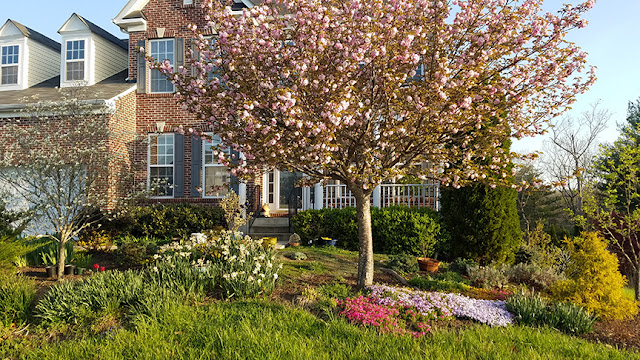 |
| Purple and peach bicolor iris. |
The term "forest bathing," became popular in Japan in the 1980's, and has made inroads here in the U.S. in the past few years. "Forest bathing" is a translation of the Japanese word shinrin-yoku. As I understand it, it's a way of immersing oneself in the spirit of the place: the trees, flowers, ferns, the whole atmosphere of the forest. Mindful meditation might be another description of the practice, slowing down and getting away from the ordinary distractions of modern life. Only the Japanese would codify it into an art!
Since I love irises, and wish to immerse myself in the spirit of this lovely flower, particularly its perfume, today I invite you to go "iris bathing" in my garden. Just think of yourself submerged in a tubful of iris flowers--everyone should try it!
 |
| Regal purple. |
This regal purple beauty didn't bloom last year, and I feared it might have disappeared somehow, but it is offering a few blooms this spring. My front bed of iris is getting overcrowded and shadier, it has not been as floriferous this year as in previous ones. I'll have to thin out this bed in late July or August when the plants are dormant, and create a new bed for the cuttings.
 |
| Iris bed in front. |
 |
| Yellow Iris bed |
On the other hand, my yellow irises in the bed on the opposite side of the driveway are spectacular this year! Combined with 'Pink Attraction' and some Dutch iris, they look stunning! Some giant Alliums fill out the display.
 |
| Lavender Dutch iris |
 | |||||
| 'Pink Attraction' iris. |
 |
| Yellow and pink iris. |
 |
| White iris with beard tongues. |
I love these white irises with pale blue beards that have little tongues on the ends--some folks refer to these as horns. I've not learned what variety they are, these were acquired with a group of unlabeled varieties.
In the back yard, the old-fashioned iris from my mother's garden have not bloomed as profusely this year either. They may be getting crowded out by the arbor vitae that have grown so large in the last few years. It may be time to dig some of these up and re-plant them elsewhere, or expand the Little Indians bed forward to allow them more room to grow.
 | |
| Old-fashioned iris from my mother's garden. |
'Victoria Falls' reigns in the Long Island bed in back this year. Earlier in April, the dwarf variety 'Bluebeard' produced some lovely blooms, but I was so busy I never took photos of them. The bi-color 'Blatant' seems to be resting this spring again, and has not produced any blooms. It put out a few flowers in the fall, so late that the frosts did them in, but they have not recovered from the attack of a beastie (ground hog or other garden pest?) that ate the rhizomes the year before last.
 |
| Iris 'Victoria Falls' |
The one color of the spectrum my iris garden lacks (hah!) is a good purple-pink or mauve shade. I'll be looking in my gardening catalogs to see which varieties might fit the bill, and perhaps there will be some new bi-colors to try out too. It's looking like it will be the time to prepare a new iris bed in the fall. The more irises, the better the iris bathing!















































